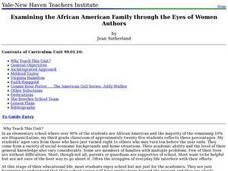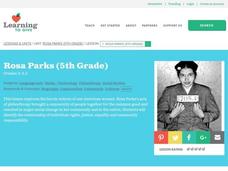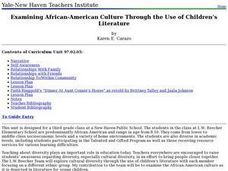Curated OER
Read and Get Smart
Use the class textbook to read a full story about Martin Luther King, Jr. The class writes facts about him and outlines his life, then they read the author and illustrator summaries at the end of the story. They compare and contrast the...
Curated OER
The Role of Protest Songs
tudents will illustrate the role, significance, and history of protest songs from the African American Civil Rights Movement. They will verbally answer the question: "What is the link between the Civil Rights Movement and Hip Hop music...
Curated OER
Broadcast from the Past
Students will be responsible for presenting (either performing live or videotaping and playing) a newscast dealing with an aspect of the Civil Rights Movement that connects to the unit topic of media and social justice. During the...
Curated OER
Martin Luther King Jr. Who Is He?
Young scholars describe MLk's leadership of the desegregation movement. Students discuss the meaning of non-violent revolution. Young scholars identify the difference between their lives and those ofcitizens in 1963. Students write a...
Curated OER
Parenting in the Movies:Examining Responsibilities in Modern American Films
Young scholars use films to identify the characteristics of a good parent. In groups, they research the different types of parenting methods used during colonial times, the Civil War and the Civil Rights movement. As a class, they...
Curated OER
Examining the African American Family through the Eyes of Women Authors
Students read stories by women authors on the characteristics of the African-American family. Using the internet, they research the history of issues that have affected African-American families from the Civil War to the Civil Rights...
Curated OER
Martin Luther King Jr.: A Clothesline Timeline
Students use print and online resources to obtain information about the life of Martin Luther King Jr. They identify important events in King's life. They sequence lists of important events by date.
Curated OER
Pay It Forward
Ninth graders practice serial reciprocity. In this "Pay It Forward," lesson, 9th graders watch the film of the same name and discuss how it mirrors work by Martin Luther King, Jr. Students then discuss service projects they can carry out...
Curated OER
Black History Project
Third graders explore and analyze about famous African-Americans by listening to four picture book biographies. They generate a list of 15 famous African-Americans and then create a survey to rank them according to importance of...
Curated OER
Religious Influence On US History
Eleventh graders explore the influence of religion on U.S. History. Using an internet database website, they research the religious affiliation of governors, Presidents and Vice-Presidents. Students write a paragraph explaining how...
National Woman's History Museum
Inventive Women - Part 2
The Declaration of Independence was published in 1776. The Declaration of Sentiments and Resolutions, modeled after the Declaration of Independence, was drafted and read by Elizabeth Cady Stanton at the Seneca Falls Convention in 1848....
Curated OER
Analyzing the economic, political, social, and cultural transformation of the United States since World War II
Eleventh graders examine political issues in the United States between 1936 and 2000. For this American history lesson, 11th graders study the economy, education, government, civil rights, and sports of this time period. Students compare...
Curated OER
Nativist and Racist Movements in the U.S. and their Aftermath
Students examine the nativist and racist movements in the history of the United States. In groups, they analyze the reactions of religious and ethnic groups to these movements and create a chart to compare the goals of each group. To...
Curated OER
A Time to Break Silence
Eleventh graders investigate Martin Luther King's decision to speak out against the war in Vietnam. For this American History lesson, 11th graders read excerpts of MLK's speech. Students examine why King made the decision to speak out.
Curated OER
The Power of Our Stories
Students compare violence to nonviolence. in this peace activity, students tell stories from their own life that show the difference between violence and nonviolence. They listen to examples of Gandhi and Martin Luther King.
Curated OER
Written Report How Music Motivates
Young scholars examine the role of music in their lives. They listen to songs from the Civil Rights movement. They explain how music effects their thinking.
Curated OER
What was life like for African Americans after the Reconstruction?
Students examine the origins and effects of Jim Crow laws and how specific legislation supported segregation. The lesson provides foundational, historical background for unit on the media's role in the social justice campaign of the...
Curated OER
The Role of Television in Social Justice
Students will discover the direct impact television coverage had on the African American Civil Rights Movement. They will employ listening, information processing, and critical thinking skills while watching the film clips and answering...
Curated OER
Map It Out!
Students open their Alabama history book to the chapter on the Civil Rights Movement noticing how the chapter is broken into headings. They read a passage and as a class, create a story map focusing on the main ideas and details.
Curated OER
The Foot Soldier Project for Civil Rights Studies
Students investigate the concept of foot soldiers with oral history. They are provided with primary and secondary resources. Students differentiate the terms of oral history versus the written record of history. They have class...
Curated OER
Individual Resistance & Social Change
Students examine the Brown v. Board of Education case. In this segregation lesson, students study the details of the case and compare it the Mendez v. Westminster case.
Curated OER
Rosa Parks
Students identify the heroic actions of Rosa Parks. In this African-American lesson, students read the book, Rosa Parks: My Storyand create a timeline of the events from the biography.
Curated OER
Children's Literature and African American Culture
Third graders examine various stories and poems and identify characteristics that make each individual unique. After analyzing the readings, they create their own personality poems to accompany self-portrait drawings. The poems and...

























